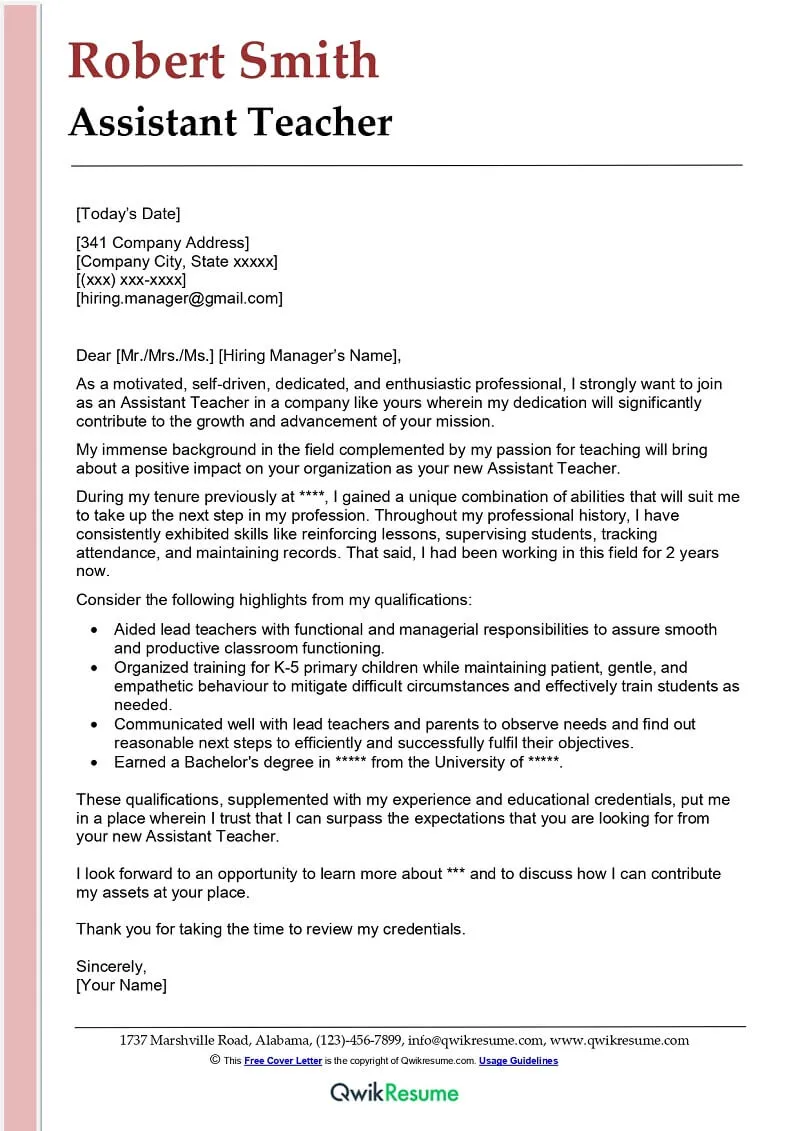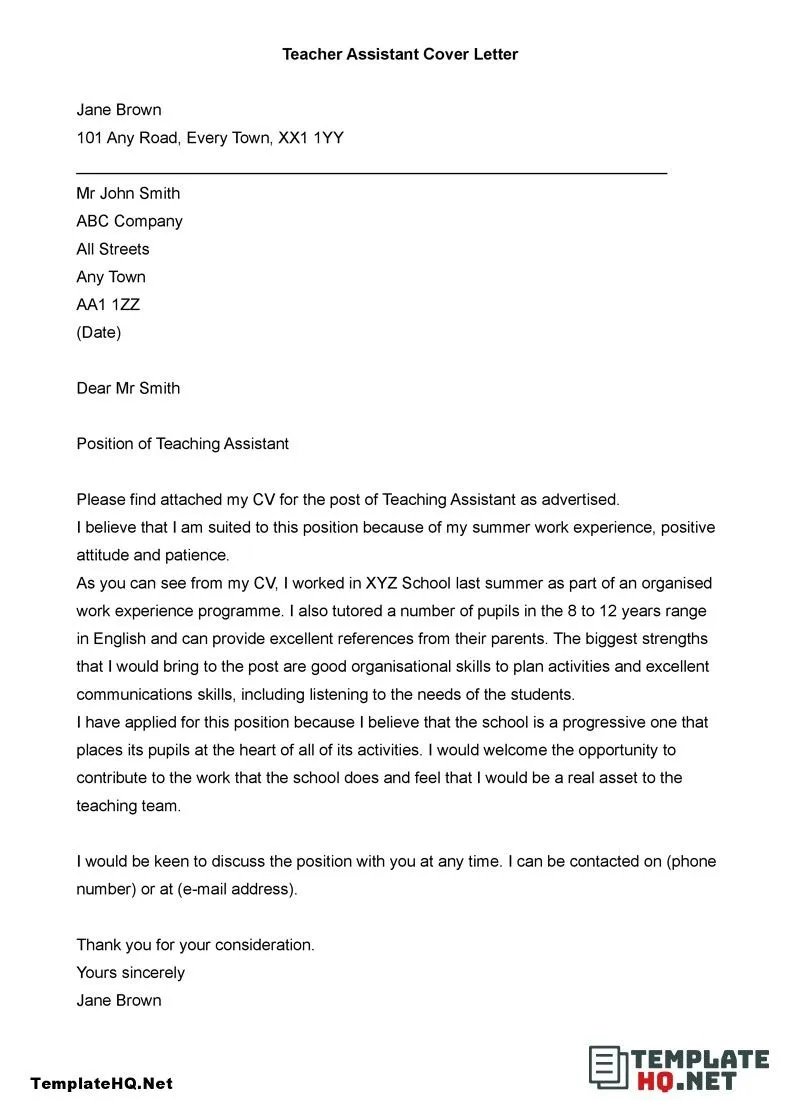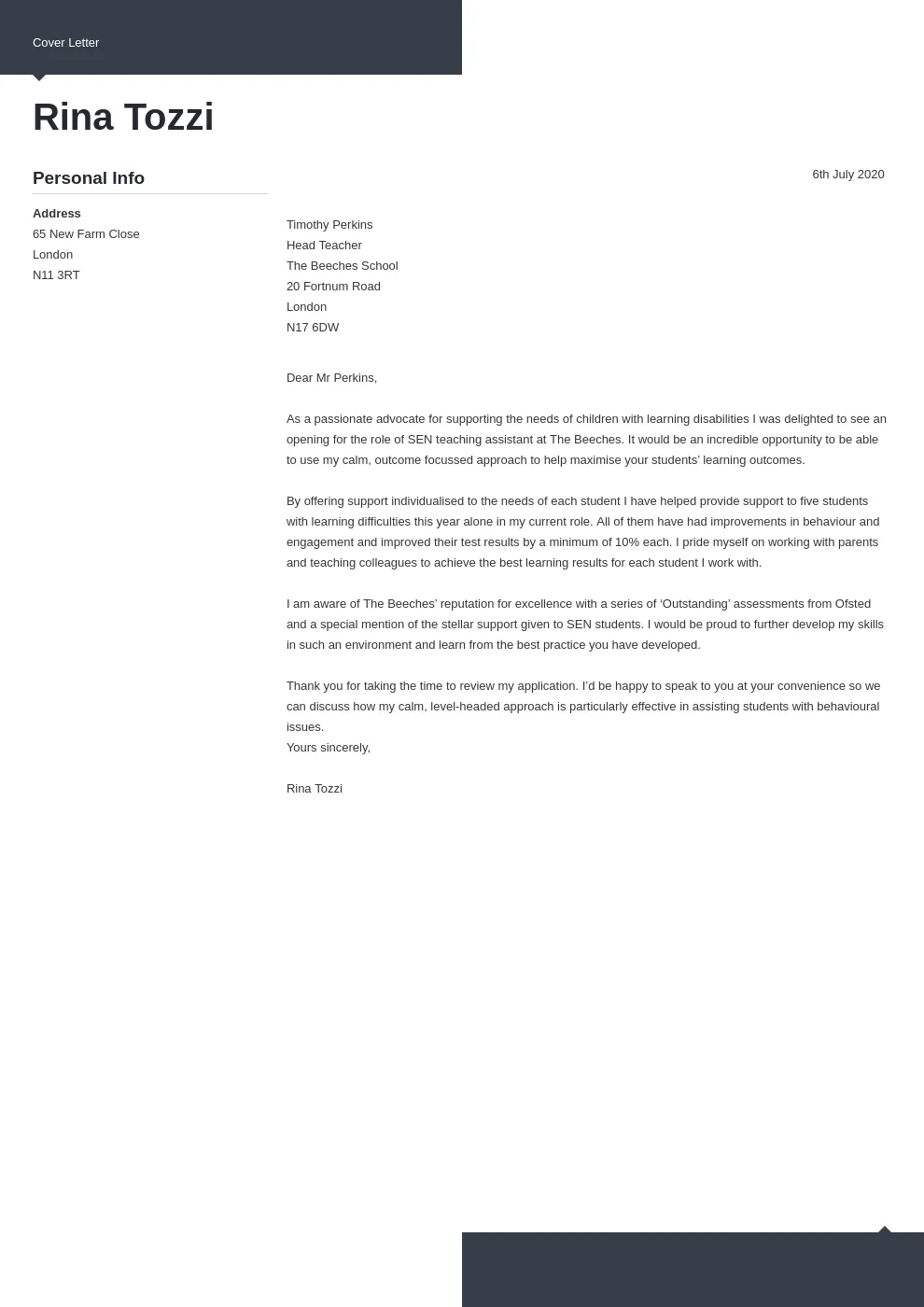Why a Teacher Assistant Cover Letter is Important
A teacher assistant cover letter is a crucial document that can significantly impact your chances of landing an interview and ultimately, the job. Unlike a resume, which provides a snapshot of your qualifications, a cover letter allows you to express your personality, enthusiasm, and genuine interest in the role. It’s your opportunity to connect with the hiring manager on a more personal level, demonstrating why you’re the ideal candidate for their specific needs. A well-crafted cover letter provides context to your resume, elaborating on your skills and experiences in a way that directly relates to the position requirements. It’s a chance to showcase your communication skills and attention to detail, which are vital qualities for a teacher assistant. In a competitive job market, a strong cover letter can be the deciding factor between getting an interview and being overlooked. Many candidates focus solely on their resume, neglecting the power of a compelling cover letter to set them apart from the competition. By investing time and effort in crafting a personalized cover letter, you demonstrate your commitment and dedication, making a positive impression on the hiring team and increasing your chances of success. The cover letter is the first impression.
Highlighting Your Skills and Experience
When writing your teacher assistant cover letter, it’s essential to highlight your skills and experience relevant to the position. Start by reviewing the job description carefully to identify the key skills and qualifications the employer is seeking. Then, draw connections between your past experiences and the requirements of the role. Provide specific examples of how you’ve demonstrated these skills in previous positions or volunteer experiences. Quantify your achievements whenever possible, using numbers and data to illustrate your impact. For example, instead of saying you assisted students, describe how you “supported a teacher in managing a classroom of 25 students, resulting in improved student engagement by 15%.” Emphasize your abilities in areas such as classroom management, communication, patience, and your capacity to connect with children. If you have experience with specific educational software, curriculum development, or working with students with special needs, make sure to mention it. Be clear and concise in your descriptions, focusing on what you accomplished and the positive results you achieved. By clearly showcasing your skills and experience, you provide the hiring manager with solid evidence that you are a well-qualified candidate. Remember to tailor your examples to match the specific needs of the school or district you are applying to. Make it clear to the hiring manager that you are the right fit.
Tailoring Your Cover Letter to the Position

One of the biggest mistakes applicants make is sending a generic cover letter. A generic cover letter is easily identifiable and is likely to be quickly dismissed. Instead, personalize your cover letter for each specific position you apply for. This involves researching the school or district and understanding its mission, values, and any specific initiatives. Address the cover letter to the hiring manager by name if possible. This shows that you’ve taken the time to do your research and are genuinely interested in the opportunity. Refer to the specific needs of the school or the challenges they may be facing, and explain how your skills and experiences can contribute to their success. Highlight any specific experiences or training that align with the job description and the school’s requirements. For instance, if the school emphasizes early literacy, mention your experience in helping students with reading. If the school has a focus on inclusive education, highlight your experience working with students with diverse learning needs. Avoid using generic phrases. Instead, use the cover letter to demonstrate that you understand the specific context and that you are capable of helping the school meet its goals. By tailoring your cover letter, you will increase your chances of making a positive impression and securing an interview. This shows that you did your research.
Key Elements to Include in Your Cover Letter
A well-structured teacher assistant cover letter should include several key elements to effectively communicate your qualifications and interest. Start with a professional header that includes your contact information and the date. Address the hiring manager by name, if available. In the opening paragraph, state the position you’re applying for and how you learned about the opportunity. Mention your enthusiasm for the role and the school or district. In the body paragraphs, highlight your relevant skills and experience, providing specific examples to support your claims. Connect your qualifications to the needs of the school, mentioning your skills and your experiences to highlight them. Use specific details to demonstrate your experience with curriculum development, classroom management, and student support. Briefly address any unique aspects of the position or school that particularly interest you. In your closing paragraph, reiterate your interest in the position and thank the hiring manager for their time and consideration. Include a call to action, such as stating that you are available for an interview and eager to discuss your qualifications further. Proofread your cover letter carefully to eliminate any grammatical errors or typos. The correct tone and grammar are essential.
Formatting Your Teacher Assistant Cover Letter
The formatting of your teacher assistant cover letter is crucial for presenting a professional and polished document. Use a clear, easy-to-read font such as Times New Roman, Arial, or Calibri. Maintain a consistent font size, typically between 11 and 12 points. Use standard margins (1 inch on all sides) to create a balanced layout. Use single-spacing within paragraphs and double-spacing between paragraphs. Divide the content into logical sections, with clear headings and subheadings, to improve readability. Keep your paragraphs concise and focused, aiming for three to five sentences each. Avoid using excessive bolding, underlining, or italics, as this can make the document appear cluttered. Use bullet points to highlight skills, achievements, or experiences, making the information easier for the reader to scan. Ensure that your cover letter is well-organized and easy to follow, making it simple for the hiring manager to grasp your qualifications. Use professional language, avoiding slang or informal terms. Finally, review your cover letter on various devices to ensure it appears correctly formatted across different platforms. Before submission, save your cover letter as a PDF file to preserve the formatting and prevent any unintended changes. Good formatting is very important.
Proofreading and Editing for Perfection

Proofreading and editing are essential steps in the cover letter writing process, and it’s very important to take these seriously. Even small mistakes can create a negative impression and undermine your credibility. After writing your cover letter, set it aside for a few hours or a day, then review it with fresh eyes. Read the cover letter slowly, paying close attention to grammar, spelling, punctuation, and sentence structure. Check for any typos, misused words, or awkward phrasing. Use spell-check and grammar-check tools, but don’t rely on them completely. These tools may not catch all errors. Ask a friend, family member, or career advisor to read your cover letter and provide feedback. They can identify mistakes that you might have missed. Pay close attention to your tone, ensuring it is professional and enthusiastic. Make sure that the cover letter is clear, concise, and easy to understand. Ensure your contact information is correct and up-to-date. After making revisions, proofread the cover letter again to catch any new errors. A polished cover letter shows attention to detail and reflects well on your professionalism. Ensure that you create the best first impression.
Showcasing Your Passion for Education
A teacher assistant cover letter is an ideal opportunity to express your passion for education and your dedication to helping students succeed. Share what motivates you to work in education and what you find rewarding about assisting teachers and students. Mention any specific teaching philosophies or approaches that resonate with you and how they align with the school’s values. Include any personal experiences that demonstrate your commitment to education. Share examples of how you’ve gone above and beyond to support students, such as volunteering in the classroom, tutoring, or participating in educational outreach programs. Convey your enthusiasm for working with children and your belief in their potential. Highlight your communication skills. Discuss your desire to create a positive and supportive learning environment. Express your eagerness to collaborate with teachers, parents, and other staff members. The more you show your passion for education, the more likely you are to make a lasting impression on the hiring team. Demonstrate that you are not just looking for a job; you have a clear vision for your career.
